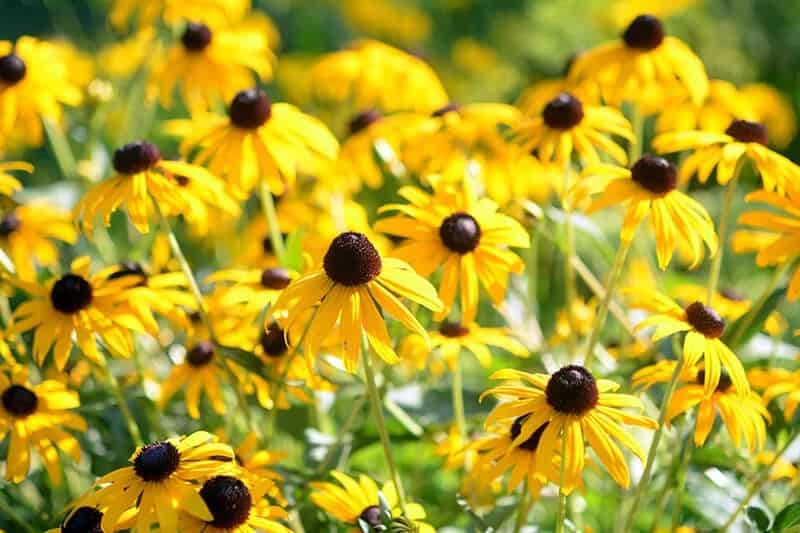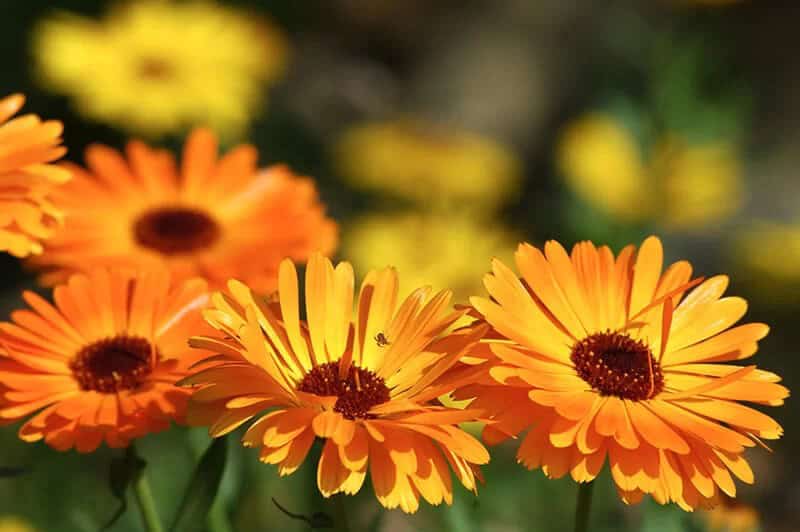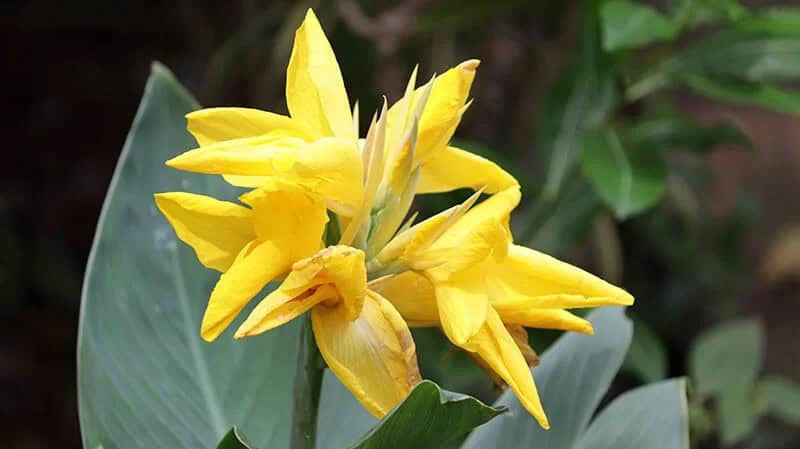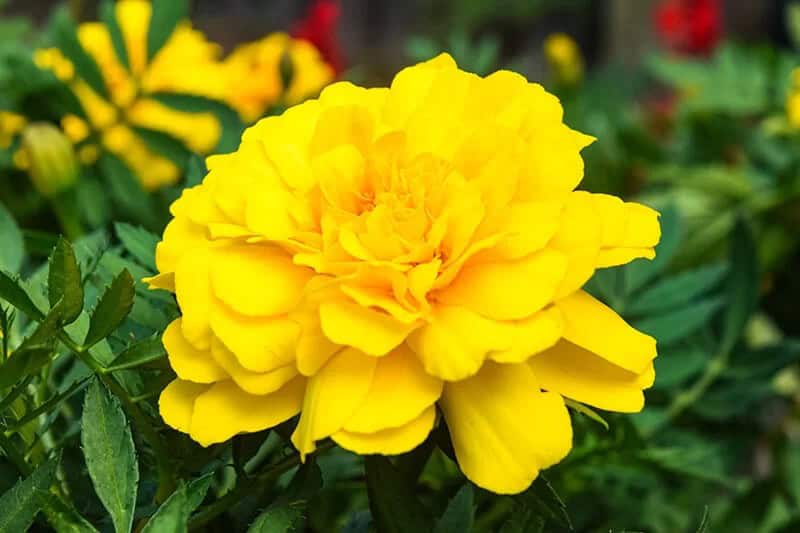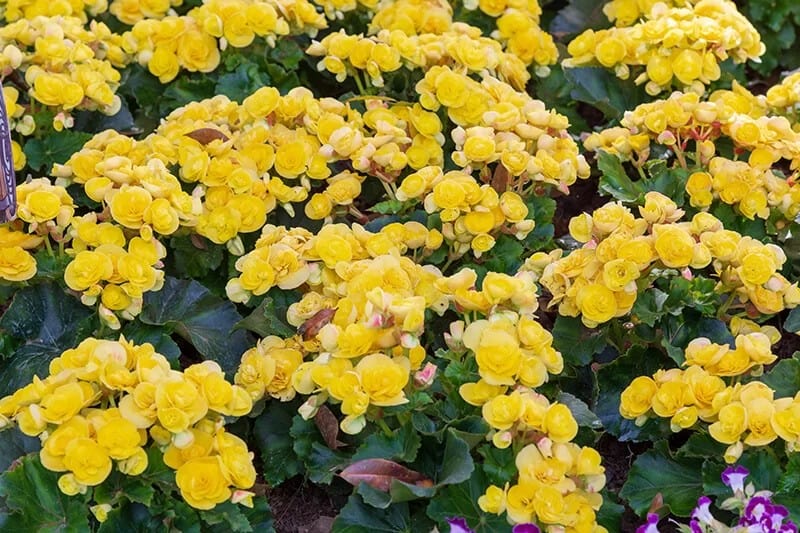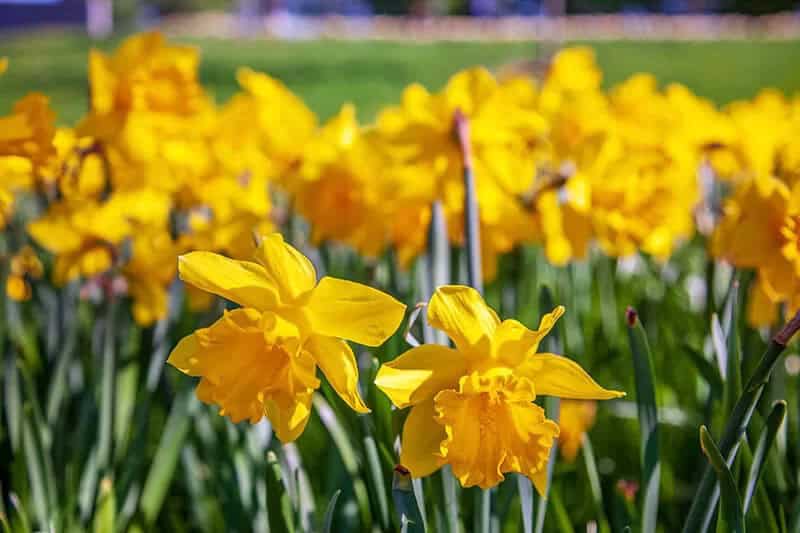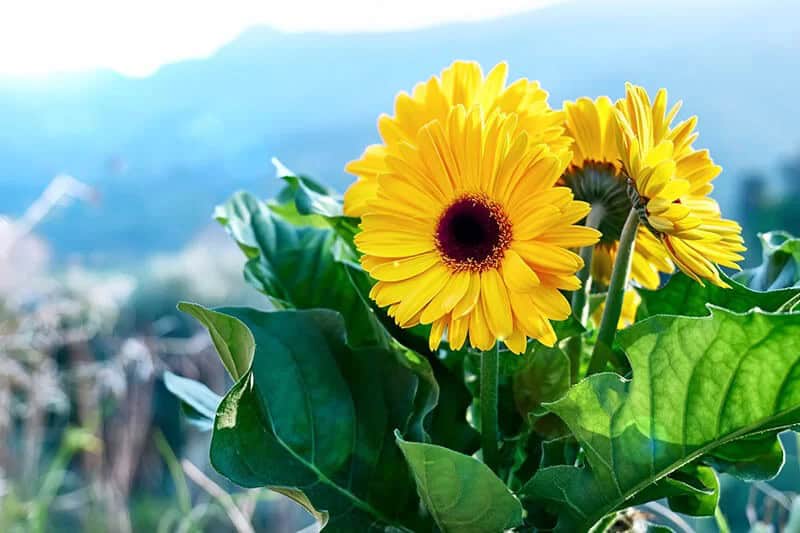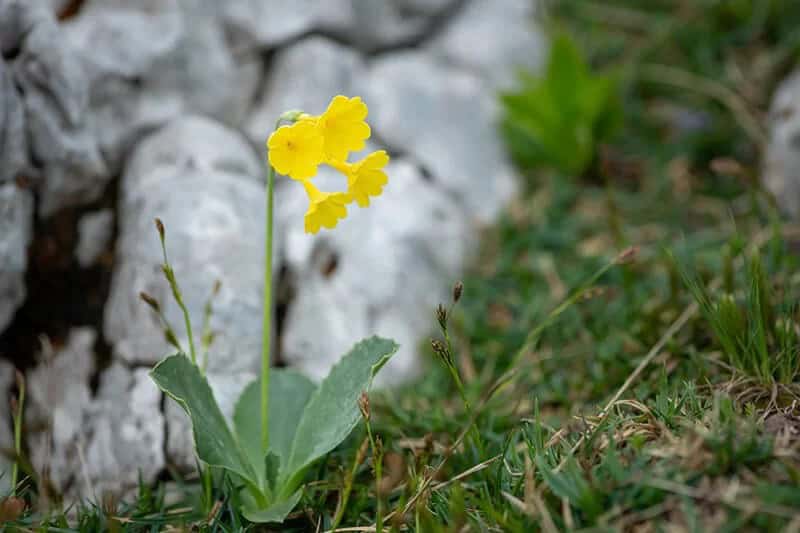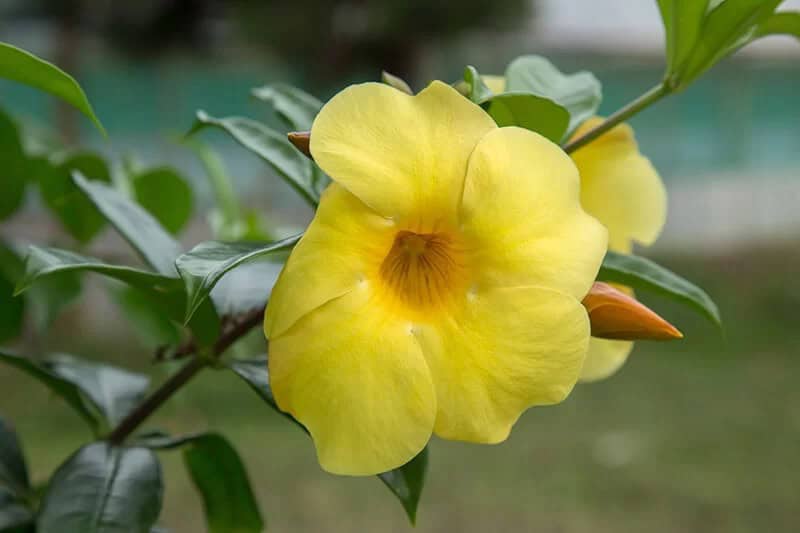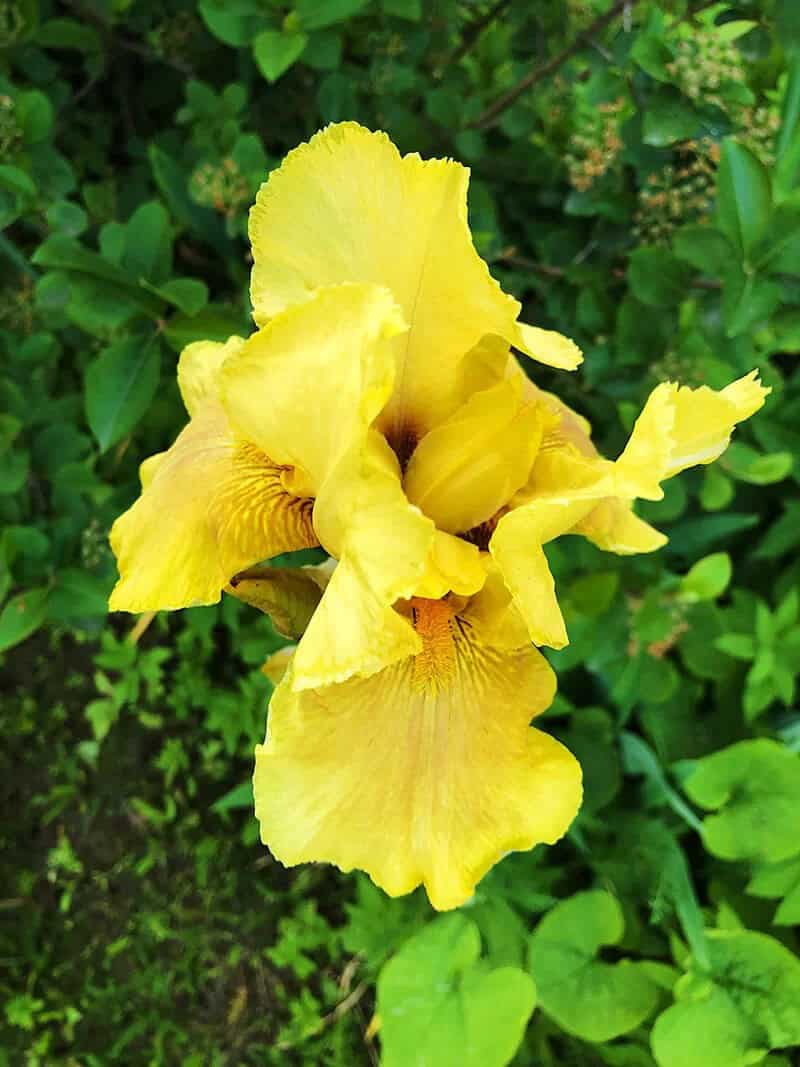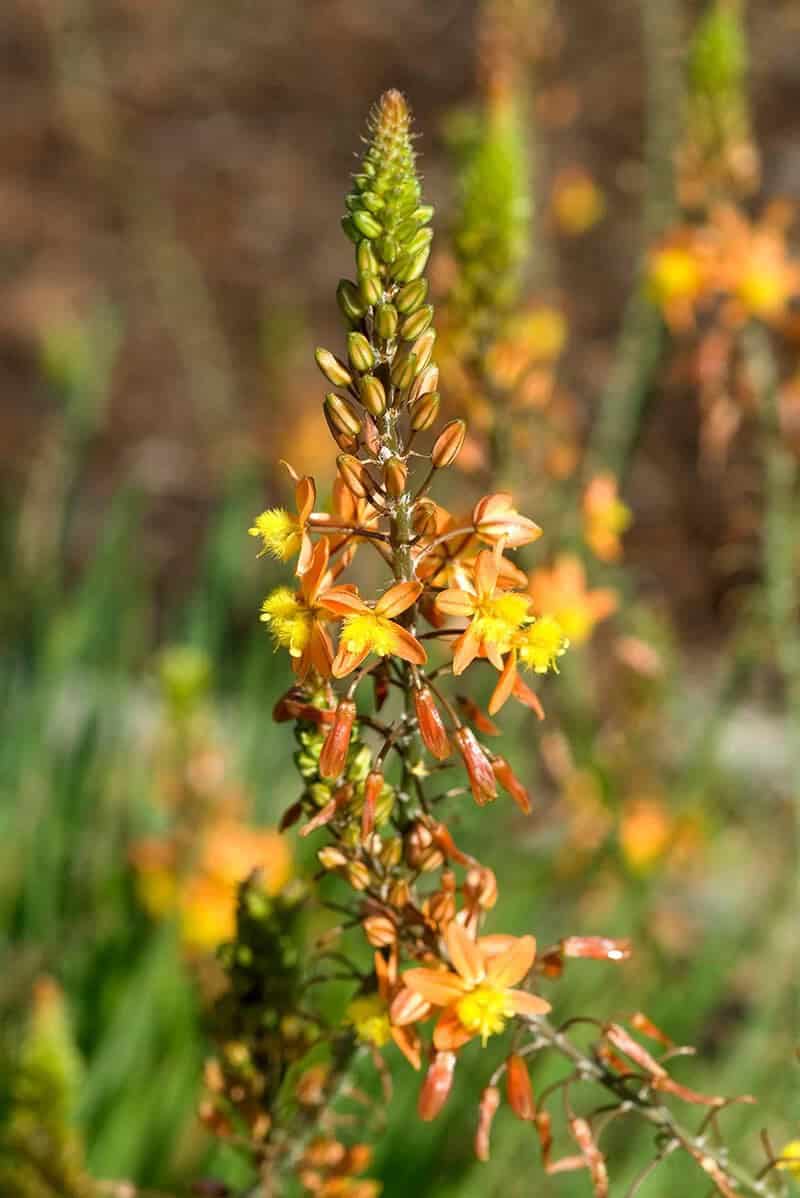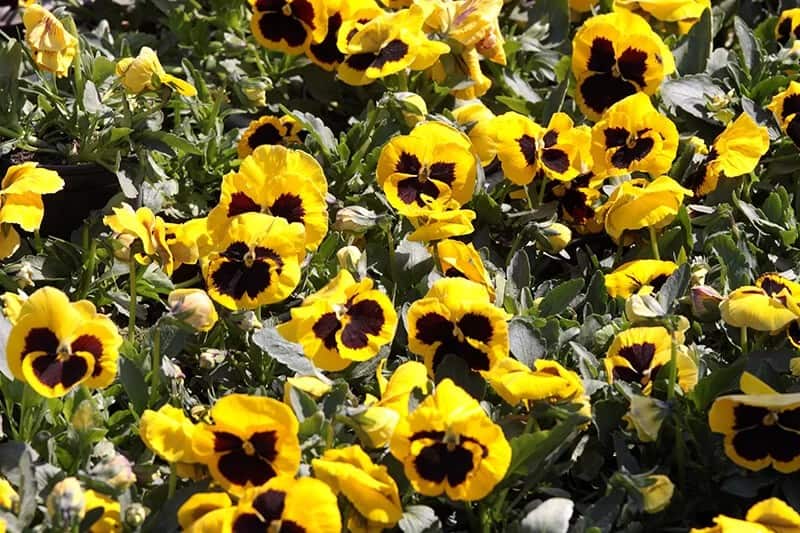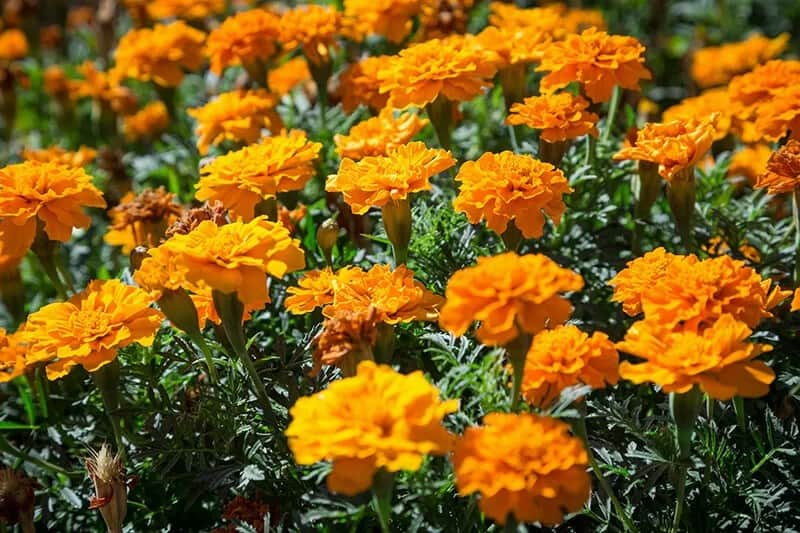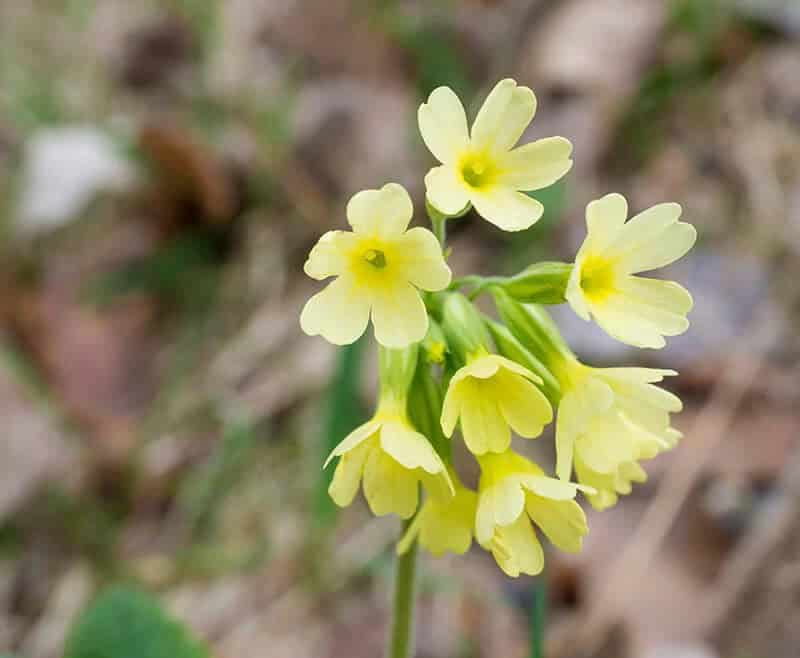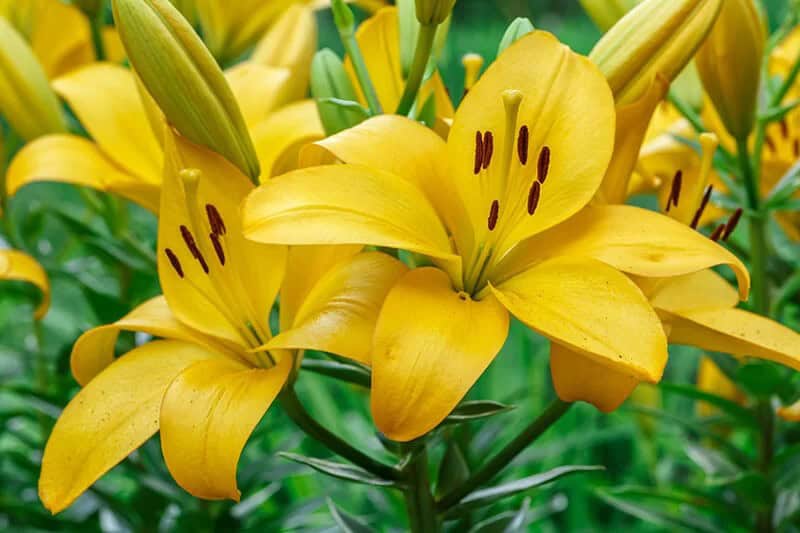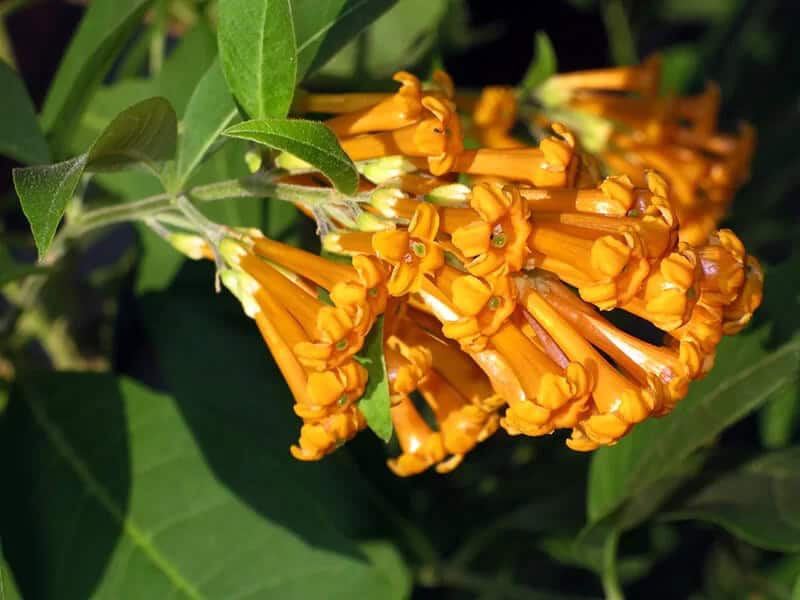If you’re seeking a pop of vibrancy in your outdoor space, consider incorporating bright yellow blooms into your garden design. Yellow flowers offer a diverse array of shapes and sizes, each boasting its own distinct personality. Whether you’re looking to add a stunning focal point or simply expand your knowledge on these radiant flowers, continue reading to discover the beauty and charm they can bring to your garden.
27 Magical Yellow Flowers that will Make Your Garden More Vibrant
Black-Eyed Susan (Scientific Name: Rudbeckia Hirta)
The Black-Eyed Susan, a native North American flower, thrives in areas with ample sunlight and moist soil. Its vibrant yellow petals and dark brown center make it a popular choice for bouquets and arrangements. What sets this flower apart is its sweet aroma, which can fill an entire room. A key characteristic of the Black-Eyed Susan is its symbolism – it represents justice. Additionally, this flower requires daily watering, as it loves water and will not survive without it.
It also prefers well-drained soil with a pH level between 6.5 to 7.05, making it suitable for growing in zones 3 to 10. While it can tolerate partial shade, it blooms best in full sun. The Black-Eyed Susan typically begins to bloom from June to October, taking around six weeks to reach its full potential. With proper care and timing, you can enjoy a bountiful harvest of these lovely flowers.
Chrysanthemum (Mums or Chrysanths)
The humble chrysanthemum boasts a rich symbolism – in yellow, it represents sorrow or neglected love. However, its beauty extends beyond mere symbolism. This versatile flower thrives in conditions that are anything but humble: it requires moist soil, rich in organic matter and well-draining, to grow its bright yellow petals with dark brown centers. In the right environments, chrysanthemums can bloom from late July to October, filling gardens and vases alike with their vibrant hues.
With growing zones spanning 5 to 9, this hardy flower is perfect for gardeners seeking a low-maintenance yet high-reward addition to their outdoor spaces. Whether cut and arranged in a bouquet or planted directly into the ground, chrysanthemums bring joy and beauty to those who cultivate them.
Bird of Paradise (Scientific Name: Strelitzia Reginae)
Bird of paradise, a tropical perennial with majestic banana-like leaves and striking bird-shaped flowers, thrives in warm climates. Its vibrant orange and blue blooms appear from mid-December to May, showcasing the plant’s impressive foliage and architectural beauty. As a member of the Musaceae family, this broadleaf evergreen requires well-drained soil, preferably mulched, and full sun or partial shade. It’s hardy in USDA zones 10 to 12, making it an ideal choice for tropical gardens.
The unique double bloom of this flowering bush is sure to captivate attention, with two striking flowers emerging above the lush foliage.
Busy Lizzie (Scientific Name: Impatiens Walleriana)
The Busy Lizzie, also known as Impatiens walleriana, is an annual flower that originated from East Africa. Its nickname ‘Busy Lizzie’ was coined after Elizabeth of Brunswick, wife of Frederick William I of Prussia, due to her reputation for gossiping and meddling in others’ affairs. This partial shade-loving flower thrives best when planted alongside plants with dark foliage or a dark backdrop, allowing its vibrant yellow petals to truly shine.
Its popularity worldwide is undeniable, with numerous varieties available, such as New Guinea impatiens, which boast large leaves and intricate patterns. When it comes to growing conditions, Busy Lizzie requires at least two inches of water per week, rich and well-manured soil with a pH between 6 and 7, full sun, and can tolerate hardiness zones from 2 to 11, making it an ideal choice for many gardens.
Calendulas (Scientific Name: Calendula Officinalis)
Calendulas, with their vibrant yellow hues, hold a special significance in various aspects of life. The 🔮 symbol associated with these flowers represents grief, despair, and sorrow, adding an air of melancholy to their beauty. When it comes to nurturing these blooms, they require 💧 moderate watering – about 1-1.5 inches per week – and thrive in well-drained soil rich in organic matter 🪴.
Their hardiness zones are typically found between 9 to 11 ☀️, and they flourish under full sun or partial shade conditions 🌍. As for their blooming season, Calendulas typically bloom from May to early Fall 🌱. Not only do these flowers boast a range of healing properties, particularly beneficial for skin health, but they also attract bees and butterflies, making them a popular choice for gardens and floral arrangements.
Canna Lily (Canna)
Canna lilies, native to southern North America, Central America, and the West Indies, have a rich symbolism associated with glory and power. These vibrant yellow flowers are popular for their ability to thrive in tropical areas where they can be planted outside year-round, multiplying rapidly from their tubers or rhizomes. Growing up to 12 feet tall and spreading about three feet, larger cannas require full sun (six hours per day or more) but can tolerate partial shade if temperatures are high.
In ideal conditions, yellow flowers bloom all summer until frost kills the plants back, allowing for a convenient harvest of the rhizomes for replanting next spring when the weather warms again. To keep your cannas happy and healthy, ensure they receive at least one to two inches of water weekly, and plant them in rich, water-retentive, and well-drained soils high in organic matter. They prefer a warm climate, thriving in hardiness zones 9 to 10.
Carnation (Scientific Name: Dianthus Caryophyllus)
The yellow carnation is one of the world’s most beloved flowers, with over 200 species to choose from, but the garden carnation remains the most iconic. Its long history dates back to ancient Greece, where it was first cultivated more than 2,500 years ago. What makes carnations truly special is their intoxicating fragrance, which many describe as sweet and floral. This attribute alone sets them apart from other flowers.
When properly cared for, carnations can last up to two weeks in a vase, making them a popular choice for arrangements. Moreover, they are relatively low-maintenance, requiring only regular watering and sufficient sunlight to flourish. With their vibrant yellow hue, fragrant aroma, and enduring longevity, it’s no wonder carnations have earned a spot as a top pick among flower enthusiasts.
If you’re looking for a stunning, scented, and easy-to-care-for bloom, the humble carnation is an excellent choice.
Bulbous Buttercup (Scientific Name: Ranunculus Bulbosus)
The bulbous buttercup, with its vibrant yellow hue and delicate appearance, is a symbol of joy, youth, friendship, and happiness. This charming flower thrives in well-drained soil and full sun or partial shade, requiring only one inch of water weekly during its blooming period from April to June. Native to most of Europe, western Asia, and northwest Africa, the bulbous buttercup’s scientific name is a nod to its affinity for watery environments, where it often grows near ponds or streams.
Its ability to reappear annually from deep underground bulbs, following a dormant period in late summer, only adds to its allure.
Begonia (Scientific Name: Begonia Obliqua)
Begonias are a diverse group of flowering plants, boasting over 1000 species that showcase an array of colors and forms. One such variety is the Begonia Obliqua, a tuberous begonia distinguished by its bright yellow blooms, which can reach up to three inches in diameter and emit a sweet fragrance. These flowers thrive in indoor and outdoor settings, making them a popular choice for gardeners, landscapers, and container enthusiasts alike.
One of the key characteristics that sets begonias apart is their ability to tolerate low light levels, making them an ideal choice for flowering plants in indoor spaces or shaded areas outdoors. Additionally, begonias are relatively low-maintenance when it comes to watering, requiring only occasional hydration every 2-4 days. They also prefer well-drained soil that’s rich in nutrients and receives full sun to partial shade.
Begonias typically bloom from early summer until the first frost, but can be planted at other times throughout the year if necessary. With proper care, these beautiful flowers will flourish in a variety of environments.
Daffodil (Scientific Name: Narcissus)
The humble daffodil, a type of narcissus flower, holds a special symbolism – rebirth and new beginnings. This symbolic beauty requires some care to thrive. It needs water weekly, making it important to check the soil moisture regularly. The ideal soil conditions for daffodils are neutral to slightly acidic, with a pH of 6. Additionally, they can grow in a variety of hardiness zones, ranging from 3 to 8. When it comes to light, these flowers prefer full sun or partial shade.
One of the most notable aspects of daffodils is their blooming season – late winter and spring. As spring flowers, they naturally bloom in meadows and woodlands. In fact, daffodils have been a part of Easter celebrations for centuries due to their early blooming times. Not only do they have a sweet fragrance described as honey-like or fruity, but they also add a pop of color with their trumpet-shaped flowers and six delicate petals each.
Gerbera Daisy (Scientific Name: Daisy Gerbera Jamesonii)
The Gerbera Daisy, a popular yellow flower plant, boasts a vibrant array of colors with bright yellow petals being its most notable feature. With their reputation for being easy to care for, these blooms can thrive for up to two weeks when properly tended. Notably, the Gerbera Daisy relies on bees for pollination, making it essential to create a bee-friendly environment nearby if you’re growing them outdoors.
To ensure optimal growth, Gerberas require full sun and well-drained soil, as well as specific water and pH conditions. They need around one inch of water per week and a slightly acidic to neutral soil pH of 5.5 to 6.5. Additionally, these flowers thrive in late spring through autumn and can tolerate hardiness zones ranging from 8 to 10.
Bear’s Ear (Scientific Name: Primula Auricula)
The Bear’s Ear (Primula Auricula) is a charming yellow flower that thrives in European wilds. Its unique leaf shape, reminiscent of a bear’s ears, lends its common name. The flowers themselves are approximately one inch across, boasting five delicate petals. They bloom mid-to-late spring, often accompanied by daffodils and bluebells.
This species requires specific conditions to flourish: it demands water weekly, tolerates partial shade, and grows well in a variety of soils ranging from sandy to loamy and heavy. The Bear’s Ear is hardy in zones 3 through 8, making it an attractive choice for gardeners in these regions.
Goldenrod (Scientific Name: Solidago)
Goldenrod is a versatile and resilient flower that exudes prosperity, happiness, and wealth. This radiant yellow bloom thrives in well-drained soil with decent drainage, tolerating average conditions without fuss. It requires weekly watering and is most at home in zones 4 to 9, where it can bask in the warmth of full sun or partial shade. As a clump-forming perennial, goldenrod produces small yet striking yellow flowers on wiry stems above its narrow leaves from late August to early October.
Whether used as a statement piece in garden beds or a border, this hardy flower is sure to bring joy and vibrancy to any outdoor space.
Hibiscus (Scientific Name: Hibiscus Hamabo)
Hibiscus, a stunning plant known for its vibrant flowers and symbolic meanings, thrives in warm climates. This tropical beauty is often associated with happiness, sunshine, and good luck. To keep your hibiscus happy and healthy, make sure it receives around 1 to 2 inches of water weekly, as well as well-drained soil. It’s also essential to plant it in a location that gets full sun, making the most of its sunny disposition.
This striking bloom can grow up to 12 inches across, with five-petaled trumpet-shaped flowers that burst forth from mid to late summer. As a member of the Malvaceae family, hibiscus is related to other showstoppers like hollyhock and okra. Its glossy green leaves add an extra layer of appeal, as do its numerous blooms that seem to be in flower all summer long.
Leontodon Flower (Leontodon)
The Leontodon flower, also known by its symbolic meaning – the lion’s tooth, boasts a unique appearance with thin, elongated stems supporting small petals in a bright yellow hue. This plant can reach heights of up to 80 centimeters and is characterized by its ability to bloom repeatedly from late May until October, with each month’s flowers emerging at the beginning of that month.
The Leontodon’s growth is fueled by underground bulbs, allowing it to thrive for many years provided proper care is given.
This hardy perennial requires well-drained, alkaline soil to flourish, as well as full sun exposure and a moderate watering schedule – once weekly, with no more than 1 inch of water. The ideal growing zones for this plant are between 5 and 9, making it suitable for cultivation in temperate climates.
Iris Flowers (Iris)
Iris flowers are a vibrant addition to any garden, boasting long, sturdy stems that support their showy blooms. While there’s an array of iris species, they all share distinctive traits. The most striking feature is the broad and flat petals, which come in a kaleidoscope of colors – yellow, blue, purple, white, and often featuring unique markings. With the right conditions, irises can thrive. They require deep watering to keep their soil consistently moist, rich, and well-drained.
These flowers are adaptable, growing in zones 5 through 9 and tolerating full sun. Expect vibrant blooms in spring or summer, making them a stunning addition to any flower garden.
Carolina Jasmine (Gelsemium Sempervirens)
The Carolina Jasmine is a stunning yellow flower plant native to the southeastern United States, renowned for its captivating fragrance and dainty blooms. This charming flowering plant thrives in full sun or partial shade, with well-drained soil being essential for optimal growth. Watering is crucial, as it requires consistent moisture levels, ideally receiving water twice a week.
The Carolina Jasmine grows best within zones 7 to 10, making it an excellent choice for gardeners seeking to add a pop of color to their outdoor spaces during the late winter to early spring bloom period. This versatile flowering plant can be grown in containers, making it a fantastic option for those with limited space. Its ability to flourish quickly and display vibrant blooms has solidified its position as a popular choice among garden enthusiasts.
Bulbine Frutescens (Scientific Name: Bulbine Frutescens)
The perennial succulent in question is a striking sight to behold, with its vibrant yellow flowers and versatile uses. Not only does it provide a pop of color and texture in the garden, but it also has medicinal properties and serves as a valuable source of food for bees. However, it’s essential to exercise caution when working with this plant, as its leaves can be toxic if ingested. As such, it’s best to keep it out of reach of children.
One way to showcase its unique beauty is by planting it alongside flowering plants with silver leaves, like rosemary and lavender, which creates a stunning contrast. When in bloom, the succulent produces dark green leaves on long stalks above ground level, while its roots grow below ground level, often emerging through cracks in rock outcroppings. If left unchecked, the plant can form large clumps over time, but these can be easily removed to maintain its desired shape and appearance.
Lesser Calendine (Scientific Name: Ficaria Verna)
The Lesser Calendine flower is a stunning perennial that thrives in many gardens. Its slender stem supports delicate blooms that unfurl during the spring season, typically from March to April. The leaves are a deep green hue with intricate purple veins, adding visual appeal to its overall appearance. As a drought-tolerant plant, it can withstand dry conditions, making it an excellent choice for gardens in hot climates.
One of its most notable features is its sweet, floral fragrance that fills the air when the flowers bloom. This unique combination of beauty and resilience has made the Lesser Calendine a popular addition to many outdoor spaces.
Pansy (Viola Tricolor)
The pansy, an annual or short-lived perennial, is characterized by its distinctive growth pattern and unique features. Its rhizomatous roots can grow up to 15 cm deep and overwinter in the soil, allowing it to thrive for a longer period. The stems are hairless and branched at times, with a slightly angled appearance. Pansies come in single or double varieties, depending on the specific cultivar.
Single flowers feature a single row of petals, while double flowers have multiple rows of petals that arise from numerous stamens transformed into petaloid structures, resembling petals but lacking their characteristic color. This flowering beauty requires specific conditions to flourish, including acidic soil with a pH range of 5.4-5.8, full sun, and weekly watering of one inch when actively growing. It thrives in zones 6 and above, blooming from September to May.
Marigold (Tagetes)
The marigold, a vibrant and aromatic flower, brings joy to any garden with its bright yellow or orange hues and potent scent. Despite their simplicity, these flowers are easy to cultivate and thrive in full sun, making them an excellent choice for gardens of all sizes. Marigolds have two notable characteristics that set them apart: their ability to repel pests and their versatility as a culinary herb.
The strong scent of the marigold flower keeps insects at bay, rendering it a valuable addition to vegetable gardens or those containing other pest-prone plants. Moreover, the leaves of the marigold can be used to add a subtle flavor boost to various dishes. With proper care, including weekly watering and a neutral soil pH between 6.0 and 7.0, these flowers will bloom from summer to fall, bringing a splash of color and fragrance to any outdoor space.
Primrose (Primula Vulgaris)
The Primrose is a cherished spring flower that thrives in pots or gardens, its symbolic significance tied to protection, safety, and love. To nurture this beauty, it demands consistent moisture, making well-draining soil a must-have. With a growing zone range of 4 to 8, partial sunlight, and an blooming season spanning from the beginning of spring to late spring, the Primrose is adaptable yet discerning.
Award-winning varieties include ‘Cowichan’, boasting large flowers; ‘Polar Star’, featuring pure white blooms on compact plants; and ‘Lilac Pink’, renowned for its fragrant pink blooms. When cultivating primroses outdoors, winter protection is essential to ensure their survival. With proper care, including watering, mulching, and protecting during the cold months, these lovely flowers can be successfully integrated into borders, rock gardens, woodland areas, and containers in any zone.
Sunflower (Helianthus)
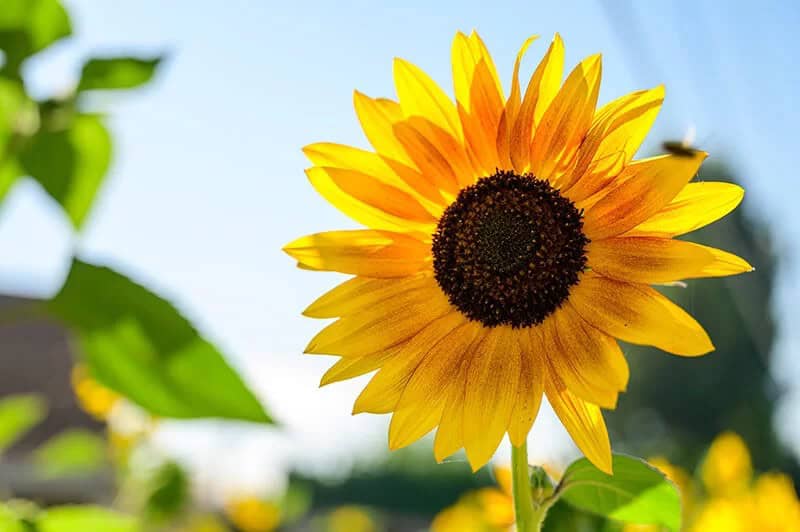
Sunflowers, with their vibrant yellow petals and towering stature, are a staple of many gardens. Native to North America, these iconic flowers thrive in a variety of habitats, from lush meadows to carefully tended fields. To coax the best out of your sunflower plants, provide them with a spot that receives full sunlight, as they can grow up to 12 feet tall. The soil should be slightly acidic or alkaline, and ideally, it would receive one inch of water per week.
With proper care, you can expect your sunflowers to bloom from summer through autumn, adding a pop of color and vibrancy to your outdoor space.
Yellow Lily (Lilium Canadense)
The yellow lily, with its trumpet-shaped blooms, is a stunning addition to any garden. Its soft, delicate petals and large flower size make it a standout feature. But beyond its aesthetic appeal, the yellow lily also holds symbolic significance. For many, it represents happiness and cheer, making it a popular choice for weddings and other celebrations. In terms of growing conditions, this lovely bloom requires 1 inch of water per week, thrives in sandy soil, and does best in zones 5 to 9.
It’s also a full-sun lover, blooming from early summer through fall. As the flowers reach their peak, they release a sweet, fragrant scent that’s hard to resist. This unique combination of beauty, symbolism, and fragrance has made the yellow lily a beloved choice for commemorating life’s milestones.
Yellow Cestrum (Cestrum Aurantiacum)
The yellow Cestrum, with its unmistakable sweet and floral fragrance, is a standout in any garden. The flower’s deep yellow petals and slightly darker center are a beautiful sight to behold. One of the plant’s most impressive features is its long-lasting blooms, which can remain fresh for up to two weeks. Not only do they boast impressive longevity, but they’re also incredibly low maintenance.
Requiring only occasional watering and no direct sunlight, this flower is perfect for busy gardeners who want to add some joy and happiness to their outdoor spaces. With a growing zone of 7 and a preference for full sun, the yellow Cestrum thrives in warm weather and can bloom from late spring or summer, adding a burst of color and fragrance to any garden.
Yellow Oleander (Cascabela Thevetia)
Yellow oleander, a tropical evergreen tree with ornamental value, can grow up to 20 feet tall and boasts yellow, funnel-shaped flowers that bloom throughout the year. To thrive, it demands full sun and cannot withstand frost. If you reside in a cold climate, consider growing it annually or keeping it indoors during winter months.
A note of caution is necessary: while beautiful, Yellow oleanders are toxic to humans and pets when ingested, making them unsuitable for households with children or pets that may roam freely around the garden area.
Ranunculus (Persian Buttercup)
The ranunculus, a delicate and elegant flower, boasts a range of characteristics that make it a popular choice for gardeners and florists alike. Its symbolism is rooted in charm, making it an ideal addition to any bouquet or arrangement. To thrive, ranunculus require regular watering, as they prefer moist and well-drained soil. They’re also quite particular about their growing conditions, thriving in zones 8 to 10 with full sun exposure.
As the seasons change, these flowers burst forth from late winter or spring, their petals unfurling in shades of yellow and white, pink, red, and orange. While they can be used as a standalone statement piece, they truly shine when placed amidst simple greenery. With time, ranunculus are likely to become a beloved favorite in your garden or arrangement.
27 Yellow Flowers to Inspire You This Season
With the perfect selection of flowers now in place, it’s essential to consider their specific requirements to ensure they thrive. Most of these varieties require full sun and well-drained soil, so make sure your garden provides these conditions. By doing so, you’ll be rewarded with vibrant blooms throughout the entire growing season. As you tend to your garden, remember to enjoy the process and appreciate the beauty that surrounds you.
